+ Open data
Open data
- Basic information
Basic information
| Entry | Database: EMDB / ID: EMD-21149 | |||||||||
|---|---|---|---|---|---|---|---|---|---|---|
| Title | Cryo-EM structure of IRP2-FBXL5-SKP1 complex | |||||||||
 Map data Map data | IRP2-FBXL5-SKP1 complex | |||||||||
 Sample Sample |
| |||||||||
 Keywords Keywords | E3 ligase / [2Fe-2S] cluster / Iron metabolism / LIGASE | |||||||||
| Function / homology |  Function and homology information Function and homology informationaconitate hydratase activity / iron-responsive element binding / citrate metabolic process / F-box domain binding / PcG protein complex / protoporphyrinogen IX biosynthetic process / positive regulation of ubiquitin protein ligase activity / Cul7-RING ubiquitin ligase complex / Loss of Function of FBXW7 in Cancer and NOTCH1 Signaling / maintenance of protein location in nucleus ...aconitate hydratase activity / iron-responsive element binding / citrate metabolic process / F-box domain binding / PcG protein complex / protoporphyrinogen IX biosynthetic process / positive regulation of ubiquitin protein ligase activity / Cul7-RING ubiquitin ligase complex / Loss of Function of FBXW7 in Cancer and NOTCH1 Signaling / maintenance of protein location in nucleus / mRNA stabilization / intestinal absorption / erythrocyte homeostasis / SCF ubiquitin ligase complex / SCF-dependent proteasomal ubiquitin-dependent protein catabolic process / ubiquitin ligase complex scaffold activity / Prolactin receptor signaling / Association of TriC/CCT with target proteins during biosynthesis / cullin family protein binding / protein monoubiquitination / ubiquitin ligase complex / ubiquitin-like ligase-substrate adaptor activity / protein K48-linked ubiquitination / Nuclear events stimulated by ALK signaling in cancer / tricarboxylic acid cycle / translation repressor activity / osteoclast differentiation / mRNA regulatory element binding translation repressor activity / Regulation of BACH1 activity / molecular function activator activity / MAP3K8 (TPL2)-dependent MAPK1/3 activation / post-embryonic development / SCF-beta-TrCP mediated degradation of Emi1 / NIK-->noncanonical NF-kB signaling / Vpu mediated degradation of CD4 / Dectin-1 mediated noncanonical NF-kB signaling / Activation of NF-kappaB in B cells / establishment of localization in cell / Degradation of GLI1 by the proteasome / Iron uptake and transport / GSK3B and BTRC:CUL1-mediated-degradation of NFE2L2 / Negative regulation of NOTCH4 signaling / Degradation of GLI2 by the proteasome / GLI3 is processed to GLI3R by the proteasome / FBXL7 down-regulates AURKA during mitotic entry and in early mitosis / Degradation of beta-catenin by the destruction complex / beta-catenin binding / NOTCH1 Intracellular Domain Regulates Transcription / CLEC7A (Dectin-1) signaling / 2 iron, 2 sulfur cluster binding / multicellular organismal-level iron ion homeostasis / SCF(Skp2)-mediated degradation of p27/p21 / Constitutive Signaling by NOTCH1 PEST Domain Mutants / Constitutive Signaling by NOTCH1 HD+PEST Domain Mutants / FCERI mediated NF-kB activation / Interleukin-1 signaling / Orc1 removal from chromatin / protein polyubiquitination / Regulation of RUNX2 expression and activity / ubiquitin-protein transferase activity / positive regulation of protein catabolic process / Cyclin D associated events in G1 / : / Regulation of PLK1 Activity at G2/M Transition / Downstream TCR signaling / Antigen processing: Ubiquitination & Proteasome degradation / Neddylation / 4 iron, 4 sulfur cluster binding / proteasome-mediated ubiquitin-dependent protein catabolic process / intracellular iron ion homeostasis / protein ubiquitination / chromatin remodeling / iron ion binding / protein domain specific binding / centrosome / perinuclear region of cytoplasm / mitochondrion / RNA binding / nucleoplasm / metal ion binding / nucleus / cytoplasm / cytosol Similarity search - Function | |||||||||
| Biological species |  Homo sapiens (human) Homo sapiens (human) | |||||||||
| Method | single particle reconstruction / cryo EM / Resolution: 3.0 Å | |||||||||
 Authors Authors | Wang H / Shi H | |||||||||
| Funding support |  United States, 1 items United States, 1 items
| |||||||||
 Citation Citation |  Journal: Mol Cell / Year: 2020 Journal: Mol Cell / Year: 2020Title: FBXL5 Regulates IRP2 Stability in Iron Homeostasis via an Oxygen-Responsive [2Fe2S] Cluster. Authors: Hui Wang / Hui Shi / Malini Rajan / Elizabeth R Canarie / Seoyeon Hong / Daniele Simoneschi / Michele Pagano / Matthew F Bush / Stefan Stoll / Elizabeth A Leibold / Ning Zheng /  Abstract: Cellular iron homeostasis is dominated by FBXL5-mediated degradation of iron regulatory protein 2 (IRP2), which is dependent on both iron and oxygen. However, how the physical interaction between ...Cellular iron homeostasis is dominated by FBXL5-mediated degradation of iron regulatory protein 2 (IRP2), which is dependent on both iron and oxygen. However, how the physical interaction between FBXL5 and IRP2 is regulated remains elusive. Here, we show that the C-terminal substrate-binding domain of FBXL5 harbors a [2Fe2S] cluster in the oxidized state. A cryoelectron microscopy (cryo-EM) structure of the IRP2-FBXL5-SKP1 complex reveals that the cluster organizes the FBXL5 C-terminal loop responsible for recruiting IRP2. Interestingly, IRP2 binding to FBXL5 hinges on the oxidized state of the [2Fe2S] cluster maintained by ambient oxygen, which could explain hypoxia-induced IRP2 stabilization. Steric incompatibility also allows FBXL5 to physically dislodge IRP2 from iron-responsive element RNA to facilitate its turnover. Taken together, our studies have identified an iron-sulfur cluster within FBXL5, which promotes IRP2 polyubiquitination and degradation in response to both iron and oxygen concentrations. | |||||||||
| History |
|
- Structure visualization
Structure visualization
| Movie |
 Movie viewer Movie viewer |
|---|---|
| Structure viewer | EM map:  SurfView SurfView Molmil Molmil Jmol/JSmol Jmol/JSmol |
| Supplemental images |
- Downloads & links
Downloads & links
-EMDB archive
| Map data |  emd_21149.map.gz emd_21149.map.gz | 8.2 MB |  EMDB map data format EMDB map data format | |
|---|---|---|---|---|
| Header (meta data) |  emd-21149-v30.xml emd-21149-v30.xml emd-21149.xml emd-21149.xml | 13.2 KB 13.2 KB | Display Display |  EMDB header EMDB header |
| Images |  emd_21149.png emd_21149.png | 53.3 KB | ||
| Filedesc metadata |  emd-21149.cif.gz emd-21149.cif.gz | 6.3 KB | ||
| Archive directory |  http://ftp.pdbj.org/pub/emdb/structures/EMD-21149 http://ftp.pdbj.org/pub/emdb/structures/EMD-21149 ftp://ftp.pdbj.org/pub/emdb/structures/EMD-21149 ftp://ftp.pdbj.org/pub/emdb/structures/EMD-21149 | HTTPS FTP |
-Validation report
| Summary document |  emd_21149_validation.pdf.gz emd_21149_validation.pdf.gz | 333.3 KB | Display |  EMDB validaton report EMDB validaton report |
|---|---|---|---|---|
| Full document |  emd_21149_full_validation.pdf.gz emd_21149_full_validation.pdf.gz | 332.9 KB | Display | |
| Data in XML |  emd_21149_validation.xml.gz emd_21149_validation.xml.gz | 6.5 KB | Display | |
| Data in CIF |  emd_21149_validation.cif.gz emd_21149_validation.cif.gz | 7.4 KB | Display | |
| Arichive directory |  https://ftp.pdbj.org/pub/emdb/validation_reports/EMD-21149 https://ftp.pdbj.org/pub/emdb/validation_reports/EMD-21149 ftp://ftp.pdbj.org/pub/emdb/validation_reports/EMD-21149 ftp://ftp.pdbj.org/pub/emdb/validation_reports/EMD-21149 | HTTPS FTP |
-Related structure data
| Related structure data |  6vcdMC M: atomic model generated by this map C: citing same article ( |
|---|---|
| Similar structure data |
- Links
Links
| EMDB pages |  EMDB (EBI/PDBe) / EMDB (EBI/PDBe) /  EMDataResource EMDataResource |
|---|---|
| Related items in Molecule of the Month |
- Map
Map
| File |  Download / File: emd_21149.map.gz / Format: CCP4 / Size: 129.7 MB / Type: IMAGE STORED AS FLOATING POINT NUMBER (4 BYTES) Download / File: emd_21149.map.gz / Format: CCP4 / Size: 129.7 MB / Type: IMAGE STORED AS FLOATING POINT NUMBER (4 BYTES) | ||||||||||||||||||||||||||||||||||||||||||||||||||||||||||||
|---|---|---|---|---|---|---|---|---|---|---|---|---|---|---|---|---|---|---|---|---|---|---|---|---|---|---|---|---|---|---|---|---|---|---|---|---|---|---|---|---|---|---|---|---|---|---|---|---|---|---|---|---|---|---|---|---|---|---|---|---|---|
| Annotation | IRP2-FBXL5-SKP1 complex | ||||||||||||||||||||||||||||||||||||||||||||||||||||||||||||
| Projections & slices | Image control
Images are generated by Spider. | ||||||||||||||||||||||||||||||||||||||||||||||||||||||||||||
| Voxel size | X=Y=Z: 1.056 Å | ||||||||||||||||||||||||||||||||||||||||||||||||||||||||||||
| Density |
| ||||||||||||||||||||||||||||||||||||||||||||||||||||||||||||
| Symmetry | Space group: 1 | ||||||||||||||||||||||||||||||||||||||||||||||||||||||||||||
| Details | EMDB XML:
CCP4 map header:
| ||||||||||||||||||||||||||||||||||||||||||||||||||||||||||||
-Supplemental data
- Sample components
Sample components
-Entire : IRP2-FBLX5-SKP1 complex
| Entire | Name: IRP2-FBLX5-SKP1 complex |
|---|---|
| Components |
|
-Supramolecule #1: IRP2-FBLX5-SKP1 complex
| Supramolecule | Name: IRP2-FBLX5-SKP1 complex / type: complex / ID: 1 / Parent: 0 / Macromolecule list: #1-#3 |
|---|---|
| Source (natural) | Organism:  Homo sapiens (human) Homo sapiens (human) |
-Macromolecule #1: Iron-responsive element binding protein 2, isoform CRA_a
| Macromolecule | Name: Iron-responsive element binding protein 2, isoform CRA_a type: protein_or_peptide / ID: 1 / Number of copies: 1 / Enantiomer: LEVO |
|---|---|
| Source (natural) | Organism:  Homo sapiens (human) Homo sapiens (human) |
| Molecular weight | Theoretical: 105.165328 KDa |
| Recombinant expression | Organism:  Trichoplusia ni (cabbage looper) Trichoplusia ni (cabbage looper) |
| Sequence | String: MDAPKAGYAF EYLIETLNDS SHKKFFDVSK LGTKYDVLPY SIRVLLEAAV RNCDGFLMKK EDVMNILDWK TKQSNVEVPF FPARVLLQD FTGIPAMVDF AAMREAVKTL GGDPEKVHPA CPTDLTVDHS LQIDFSKCAI QNAPNPGGGD LQKAGKLSPL K VQPKKLPC ...String: MDAPKAGYAF EYLIETLNDS SHKKFFDVSK LGTKYDVLPY SIRVLLEAAV RNCDGFLMKK EDVMNILDWK TKQSNVEVPF FPARVLLQD FTGIPAMVDF AAMREAVKTL GGDPEKVHPA CPTDLTVDHS LQIDFSKCAI QNAPNPGGGD LQKAGKLSPL K VQPKKLPC RGQTTCRGSC DSGELGRNSG TFSSQIENTP ILCPFHLQPV PEPETVLKNQ EVEFGRNRER LQFFKWSSRV FK NVAVIPP GTGMAHQINL EYLSRVVFEE KDLLFPDSVV GTDSHITMVN GLGILGWGVG GIETEAVMLG LPVSLTLPEV VGC ELTGSS NPFVTSIDVV LGITKHLRQV GVAGKFVEFF GSGVSQLSIV DRTTIANMCP EYGAILSFFP VDNVTLKHLE HTGF SKAKL ESMETYLKAV KLFRNDQNSS GEPEYSQVIQ INLNSIVPSV SGPKRPQDRV AVTDMKSDFQ ACLNEKVGFK GFQIA AEKQ KDIVSIHYEG SEYKLSHGSV VIAAVISCTN NCNPSVMLAA GLLAKKAVEA GLRVKPYIRT SLSPGSGMVT HYLSSS GVL PYLSKLGFEI VGYGCSTCVG NTAPLSDAVL NAVKQGDLVT CGILSGNKNF EGRLCDCVRA NYLASPPLVV AYAIAGT VN IDFQTEPLGT DPTGKNIYLH DIWPSREEVH RVEEEHVILS MFKALKDKIE MGNKRWNSLE APDSVLFPWD LKSTYIRC P SFFDKLTKEP IALQAIENAH VLLYLGDSVT TDHISPAGSI ARNSAAAKYL TNRGLTPREF NSYGARRGND AVMTRGTFA NIKLFNKFIG KPAPKTIHFP SGQTLDVFEA AELYQKEGIP LIILAGKKYG SGNSRDWAAK GPYLLGVKAV LAESYEKIHK DHLIGIGIA PLQFLPGENA DSLGLSGRET FSLTFPEELS PGITLNIQTS TGKVFSVIAS FEDDVEITLY KHGGLLNFVA R KFS UniProtKB: Iron-responsive element-binding protein 2 |
-Macromolecule #2: F-box/LRR-repeat protein 5
| Macromolecule | Name: F-box/LRR-repeat protein 5 / type: protein_or_peptide / ID: 2 / Number of copies: 1 / Enantiomer: LEVO |
|---|---|
| Source (natural) | Organism:  Homo sapiens (human) Homo sapiens (human) |
| Molecular weight | Theoretical: 54.832441 KDa |
| Recombinant expression | Organism:  |
| Sequence | String: EHSTGITHLP PEVMLSIFSY LNPQELCRCS QVSMKWSQLT KTGSLWKHLY PVHWARGDWY SGPATELDTE PDDEWVKNRK DESRAFHEW DEDADIDESE ESAEESIAIS IAQMEKRLLH GLIHNVLPYV GTSVKTLVLA YSSAVSSKMV RQILELCPNL E HLDLTQTD ...String: EHSTGITHLP PEVMLSIFSY LNPQELCRCS QVSMKWSQLT KTGSLWKHLY PVHWARGDWY SGPATELDTE PDDEWVKNRK DESRAFHEW DEDADIDESE ESAEESIAIS IAQMEKRLLH GLIHNVLPYV GTSVKTLVLA YSSAVSSKMV RQILELCPNL E HLDLTQTD ISDSAFDSWS WLGCCQSLRH LDLSGCEKIT DVALEKISRA LGILTSHQSG FLKTSTSKIT STAWKNKDIT MQ STKQYAC LHDLTNKGIG EEIDNEHPWT KPVSSENFTS PYVWMLDAED LADIEDTVEW RHRNVESLCV METASNFSCS TSG CFSKDI VGLRTSVCWQ QHCASPAFAY CGHSFCCTGT ALRTMSSLPE SSAMCRKAAR TRLPRGKDLI YFGSEKSDQE TGRV LLFLS LSGCYQITDH GLRVLTLGGG LPYLEHLNLS GCLTITGAGL QDLVSACPSL NDEYFYYCDN INGPHADTAS GCQNL QCGF RACCRSGE UniProtKB: F-box/LRR-repeat protein 5 |
-Macromolecule #3: S-phase kinase-associated protein 1
| Macromolecule | Name: S-phase kinase-associated protein 1 / type: protein_or_peptide / ID: 3 / Number of copies: 1 / Enantiomer: LEVO |
|---|---|
| Source (natural) | Organism:  Homo sapiens (human) Homo sapiens (human) |
| Molecular weight | Theoretical: 18.679965 KDa |
| Recombinant expression | Organism:  |
| Sequence | String: MPSIKLQSSD GEIFEVDVEI AKQSVTIKTM LEDLGMDDEG DDDPVPLPNV NAAILKKVIQ WCTHHKDDPP PPEDDENKEK RTDDIPVWD QEFLKVDQGT LFELILAANY LDIKGLLDVT CKTVANMIKG KTPEEIRKTF NIKNDFTEEE EAQVRKENQW C EEK UniProtKB: S-phase kinase-associated protein 1 |
-Macromolecule #4: FE2/S2 (INORGANIC) CLUSTER
| Macromolecule | Name: FE2/S2 (INORGANIC) CLUSTER / type: ligand / ID: 4 / Number of copies: 1 / Formula: FES |
|---|---|
| Molecular weight | Theoretical: 175.82 Da |
| Chemical component information | 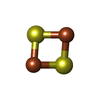 ChemComp-FES: |
-Experimental details
-Structure determination
| Method | cryo EM |
|---|---|
 Processing Processing | single particle reconstruction |
| Aggregation state | particle |
- Sample preparation
Sample preparation
| Buffer | pH: 8 |
|---|---|
| Grid | Details: unspecified |
| Vitrification | Cryogen name: ETHANE |
- Electron microscopy
Electron microscopy
| Microscope | FEI TITAN KRIOS |
|---|---|
| Image recording | Film or detector model: GATAN K2 SUMMIT (4k x 4k) / Average electron dose: 73.8 e/Å2 |
| Electron beam | Acceleration voltage: 300 kV / Electron source:  FIELD EMISSION GUN FIELD EMISSION GUN |
| Electron optics | Illumination mode: OTHER / Imaging mode: BRIGHT FIELD |
| Experimental equipment |  Model: Titan Krios / Image courtesy: FEI Company |
- Image processing
Image processing
| Startup model | Type of model: INSILICO MODEL / In silico model: generated by relion |
|---|---|
| Final reconstruction | Applied symmetry - Point group: C1 (asymmetric) / Resolution.type: BY AUTHOR / Resolution: 3.0 Å / Resolution method: FSC 0.143 CUT-OFF / Number images used: 955060 |
| Initial angle assignment | Type: MAXIMUM LIKELIHOOD |
| Final angle assignment | Type: MAXIMUM LIKELIHOOD |
 Movie
Movie Controller
Controller




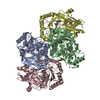

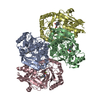
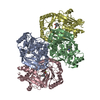
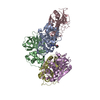

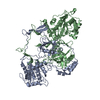




















 Z (Sec.)
Z (Sec.) Y (Row.)
Y (Row.) X (Col.)
X (Col.)





















